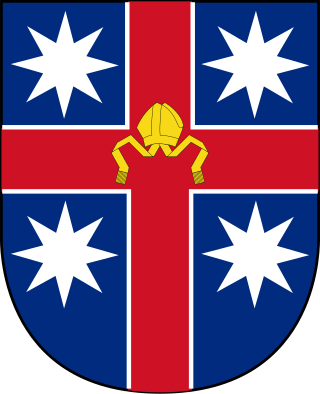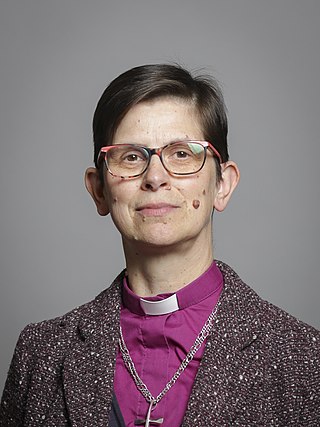Related Research Articles

The Church of England is the established Christian church in England. It traces its history to the Christian church recorded as existing in the Roman province of Britain by the 3rd century and to the 6th-century Gregorian mission to Kent led by Augustine of Canterbury. Its adherents are called Anglicans.
Since the 1990s, the Anglican Communion has struggled with controversy regarding homosexuality in the church. In 1998, the 13th Lambeth Conference of Anglican bishops passed a resolution "rejecting homosexual practice as incompatible with Scripture". However, this is not legally binding. "Like all Lambeth Conference resolutions, it is not legally binding on all provinces of the Communion, including the Church of England, though it commends an essential and persuasive view of the attitude of the Communion." "Anglican national churches in Brazil, South Africa, South India, New Zealand and Canada have taken steps toward approving and celebrating same-sex relationships amid strong resistance among other national churches within the 80 million-member global body. The Episcopal Church in the U.S. has allowed same-sex marriage since 2015, and the Scottish Episcopal Church has allowed same-sex marriage since 2017." "Church of England clergy have appeared to signal support for gay marriage after they rejected a bishops' report which said that only a man and woman could marry in church." At General Synod in 2019, the Church of England announced that same-gender couples may remain recognised as married after one spouse experiences a gender transition. In 2023, the Church of England announced that it would authorise "prayers of thanksgiving, dedication and for God's blessing for same-sex couples."

The Anglican Church of Australia, formerly known as the Church of England in Australia and Tasmania, is a Christian church in Australia and an autonomous church of the Anglican Communion. It is the second largest church in Australia after the Catholic Church. According to the 2016 census, 3.1 million Australians identify as Anglicans. As of 2016, the Anglican Church of Australia had more than 3 million nominal members and 437,880 active baptised members. For much of Australian history since the arrival of the First Fleet in January 1788, the church was the largest religious denomination. It remains today one of the largest providers of social welfare services in Australia.
A churchwarden is a lay official in a parish or congregation of the Anglican Communion or Catholic Church, usually working as a part-time volunteer. In the Anglican tradition, holders of these positions are ex officio members of the parish board, usually called a vestry, parochial church council, or in the case of a Cathedral parish the chapter.
The General Synod is the tricameral deliberative and legislative organ of the Church of England. The synod was instituted in 1970, replacing the Church Assembly, and is the culmination of a process of rediscovering self-government for the Church of England that had started in the 1850s.
A provincial episcopal visitor (PEV), popularly known as a flying bishop, is a Church of England bishop assigned to minister to many of the clergy, laity and parishes who on grounds of theological conviction, "are unable to receive the ministry of women bishops or priests". The system by which such bishops oversee certain churches is referred to as alternative episcopal oversight (AEO).
Apostolicae curae is the title of an apostolic letter, issued in 1896 by Pope Leo XIII, declaring all Anglican ordinations to be "absolutely null and utterly void". The Anglican Communion made no official reply, but the archbishops of Canterbury and York of the Church of England published a response known by its Latin title Saepius officio in 1897.
In 2003, the Lambeth Commission on Communion was appointed by the Anglican Communion to study problems stemming from the consecration of Gene Robinson, the first noncelibate self-identifying gay priest to be ordained as an Anglican bishop, in the Episcopal Church in the United States and the blessing of same-sex unions in the Anglican Diocese of New Westminster. The Commission, chaired by Archbishop Robin Eames, published its findings as the Windsor Report on 18 October 2004. The report recommended a covenant for the Anglican Communion, an idea that did not come to fruition.

The Anglican ministry is both the leadership and agency of Christian service in the Anglican Communion. "Ministry" commonly refers to the office of ordained clergy: the threefold order of bishops, priests and deacons. More accurately, Anglican ministry includes many laypeople who devote themselves to the ministry of the church, either individually or in lower/assisting offices such as lector, acolyte, sub-deacon, Eucharistic minister, cantor, musicians, parish secretary or assistant, warden, vestry member, etc. Ultimately, all baptized members of the church are considered to partake in the ministry of the Body of Christ.
In the United States, the history of the Episcopal Church has its origins in the Church of England, a church which stresses its continuity with the ancient Western church and claims to maintain apostolic succession. Its close links to the Crown led to its reorganization on an independent basis in the 1780s. In the nineteenth and early twentieth centuries, it was characterized sociologically by a disproportionately large number of high status Americans as well as English immigrants; for example, more than a quarter of all presidents of the United States have been Episcopalians. Although it was not among the leading participants of the abolitionist movement in the early 19th century, by the early 20th century its social engagement had increased to the point that it was an important participant in the Social Gospel movement, though it never provided much support for the Prohibitionist movement. Like other mainline churches in the United States, its membership decreased from the 1960s. This was also a period in which the church took a more open attitude on the role of women and toward homosexuality, while engaging in liturgical revision parallel to that of the Roman Catholic Church in the post Vatican II era.
The Bishop of Ebbsfleet is a suffragan bishop who fulfils the role of a provincial episcopal visitor in the Church of England. From its creation in 1994 to 2022, the Bishop of Ebbsfleet served conservative Anglo-Catholic parishes that reject the ordination of women as priests and bishops. Since 2023, the bishop has served conservative evangelical parishes that reject the ordination and/or leadership of women due to complementarian beliefs.
The Anglican realignment is a movement among some Anglicans to align themselves under new or alternative oversight within or outside the Anglican Communion. This movement is primarily active in parts of the Episcopal Church in the United States and the Anglican Church of Canada. Two of the major events that contributed to the movement were the 2002 decision of the Diocese of New Westminster in Canada to authorise a rite of blessing for same-sex unions, and the nomination of two openly gay priests in 2003 to become bishops. Jeffrey John, an openly gay priest with a long-time partner, was appointed to be the next Bishop of Reading in the Church of England and the General Convention of the Episcopal Church ratified the election of Gene Robinson, an openly gay non-celibate man, as Bishop of New Hampshire. Jeffrey John ultimately declined the appointment due to pressure.

The ordination of women in the Anglican Communion has been increasingly common in certain provinces since the 1970s. Several provinces, however, and certain dioceses within otherwise ordaining provinces, continue to ordain only men. Disputes over the ordination of women have contributed to the establishment and growth of progressive tendencies, such as the Anglican realignment and Continuing Anglican movements.

Donald Spargo Allister is a retired Church of England bishop. He was the Archdeacon of Chester from 2002 to 2010 and on 5 November 2009 was nominated as the next Bishop of Peterborough. He was installed on 17 April 2010 and retired in January 2023.

Jack Leo Iker is a retired American bishop of the Anglican Church in North America.

Philip John North is a bishop in the Church of England. Since April 2023, he has served as Bishop of Blackburn, the diocesan bishop of the Diocese of Blackburn. He was previously Bishop of Burnley, a suffragan bishop in the same diocese, since 2015; and team rector of the parish of Old St Pancras.

St Alban the Martyr, Birmingham is a Grade II* listed Church of England parish church in the Anglican Diocese of Birmingham. It is dedicated to Saint Alban, the first British Christian martyr.

Elizabeth Jane Holden Lane is a British Anglican bishop and Lord Spiritual. Since February 2019, she has served as Bishop of Derby in the Church of England, the diocesan bishop of the Diocese of Derby. From January 2015 to 2019, she was the Bishop of Stockport, a suffragan bishop in the Diocese of Chester. She was the first woman to be appointed as a bishop by the Church of England, after its general synod voted in July 2014 to allow women to become bishops. Her consecration took place on 26 January 2015 at York Minster.

The Lords Spiritual (Women) Act 2015 is an Act of Parliament of the United Kingdom. It stipulates that whenever a vacancy arises among the Lords Spiritual during the next ten years after the Act comes into force, the position has to be filled by a woman, if there is one who is eligible. In this case, the Act supersedes section 5 of the Bishoprics Act 1878, which would otherwise require "the issue of a writ of summons to that bishop of a see in England who having been longest bishop of a see in England has not previously become entitled to such writ". It does not apply to the five sees of Canterbury, York, London, Durham or Winchester, which are always represented in the House of Lords.

Christ Church is a Church of England, Evangelical parish church in Paignton, Devon, England. Designed by Walter G. Couldrey and Edward Gabriel, the church was built in 1887–88 and has been a Grade II listed building since 1993.
References
- ↑ "Priests (Ordination of Women) Measure 1993". legislation.gov.uk. 5 November 1993. Retrieved 31 August 2012.
- ↑ "I hope that I need detain the House".
- ↑ "Bishops and Priests (Consecration and Ordination of Women) Measure 2014". legislation.gov.uk. Retrieved 3 February 2015.
- ↑ "Priests (Ordination of Women) Measure 1993". Church Society. Retrieved 31 January 2017.